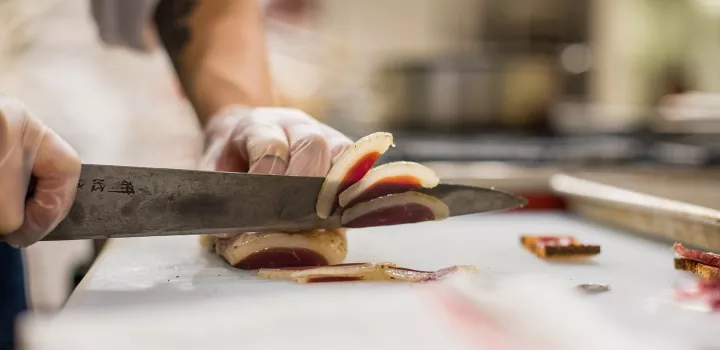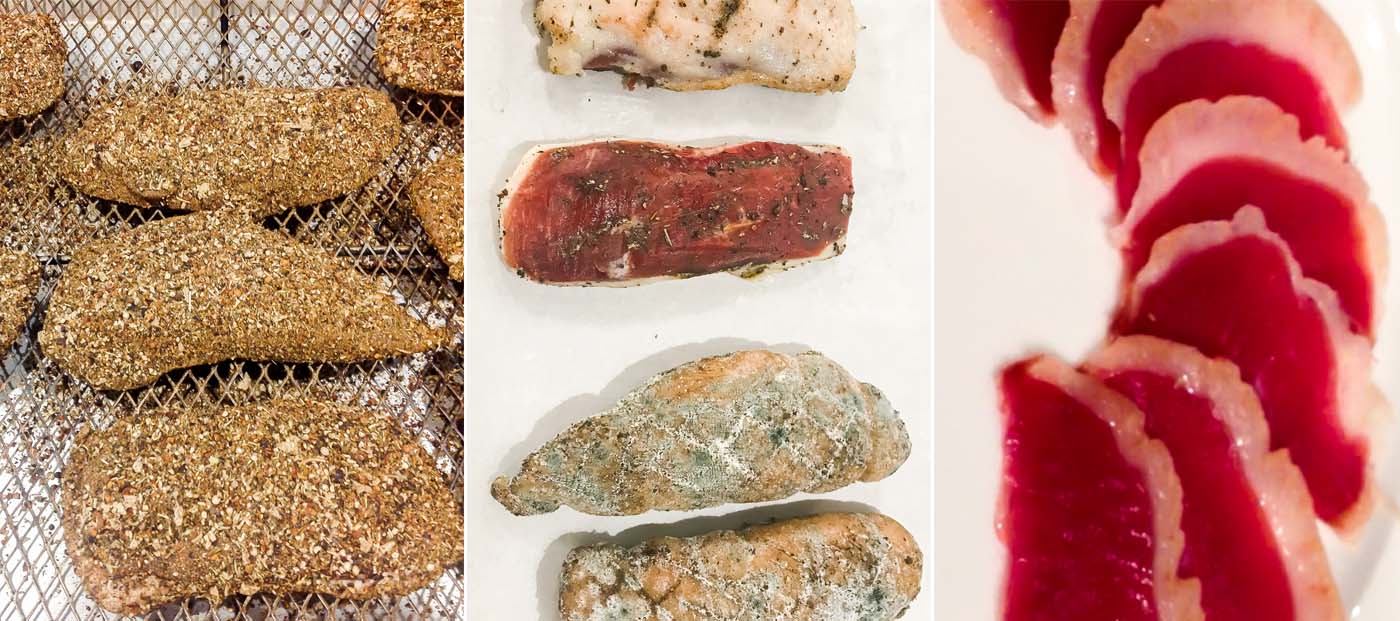
Salt: The Great Transformer
ICE Chef-Instructor Ted Siegel demonstrates the power of salt with a duck prosciutto recipe.
I have always been fascinated by the process in which salt transforms proteins into preparations that have the appearance of being cooked, but are truly not — and yet, are safe to consume. How does this happen? It is a very simple process that dates back thousands of years in human history when meat, poultry and fish had to be stored without any type of refrigeration as we know it today.
The process is simply applying a dry rub, cure or brine in which the main component is salt (kosher or sea salt) with the possible addition of other aromatics like black pepper, garlic, fresh or dried herbs, spices or sugar. With a brine, add a dry rub or cure to a liquid base, such as water, stock or broth bouillon with optional fruit juices, cider or alcohol.
The primary phase of curing and preserving is coating the protein with the salt cure and allowing it to sit for a specific amount of time, which is determined by a temperature, weight and size relationship. A brine functions as a marinade when the protein is submerged in it. Salt is the primary flavor enhancer, but it is critically pulling moisture out of the muscle fibers and dehydrating them. This process will prevent pathogens from contaminating the meat, which would make it unsafe to consume. Once the protein has been cured for the appropriate amount of time, it is removed from the dry rub cure and lightly washed with wine or water to remove excess rub, dried, then hung to start the aging process. This is again based on temperature, time, weight and size, with humidity factored into the equation.
During the aging process, the protein starts developing its specific flavor profile. While it's hanging and air drying, a fermentation process is occurring, in which acids (particularly lactic acid produced by lactobacillus bacteria) are cooking the muscle fibers, breaking down connective tissue for tenderization, and fighting off pathogenic micro-organisms that do not like acid, such as clostridium botulinum bacteria that cause the foodborne illness, botulism. Even though the process is simple in concept, there is a complicated science that drives it and an intuitive aspect, which cannot simply be defined by sight, touch, smell or taste.
Another important factor in flavor development is terroir, which can be affected by:
- breed or variety of animals or livestock
- diet of the animal-specific types of fatty acids concentrated in body fat and muscle fibers
- air animals breathe
- water animals drink
- pharmaceuticals (steroids, growth hormones, antibiotics)
- micro-organisms in the soil of the crops that the animals feed on
- conventional vs. organic crops
- use of GMOs
- how much the animals exercise
- whether the animals are raised humanely or cruelly
- how the animals are slaughtered
- how the carcasses are handled after slaughtering
- micro-organisms in the environment where the meat is aged
A very simple preparation to start out with, particularly for those intimidated by this process, is a "prosciutto" (usually dry cured ham) of duck or goose. It does not require a lot of time, ingredients or space to accomplish this. Normally, the breasts are simply cured with salt and aromatics for a day or two depending on the size. The breast of a Moularde duck is ideal — a hybrid of a female Pekin and male Muscovy duck, the breed is used primarily for the production of foie gras in North America and Europe, and it is larger and more flavorful than a Pekin duck breast.

Duck and goose prosciutto is a specialty of a few regions of Northern Italy, such as Alto-Adige (the Italian Tyrol), the Aosta Valley, and the Alpine zones of Piedmonte, Lombardy and Friuli-Venezia Guilia. Ducks and geese are basic staples here, where duck fat and goose fat are important cooking mediums. In fact, both cook with virtually no olive oil in Alto-Adige, because of the cold, temperate Alpine climate.
As previously pointed out, the salt is not just providing flavor but has a preservation effect and tenderizing effect by breaking down and gelatinizing the proteins in the muscle fibers, which has the same function as “cooking” the protein. The prosciutto does not need fancy garnishes or sauces that would detract from the subtle flavors or silky textures of the finished product. Here's a recipe to see the salt effect.
Recipe
Ingredients
- 1 whole goose or Moularde duck breast, boneless and split, tenderloins and sinew removed
- Kosher salt, as needed
- 8 juniper berries, crushed
- 12 black peppercorns, crushed
- 1 teaspoon fresh thyme, chopped
- 1 teaspoon fresh rosemary, chopped
- 1/2 teaspoon sodium nitrate (curing salt)
- 5 cloves garlic, minced
Directions
- Combine the dry ingredients in a mixing bowl and blend thoroughly.
- Add two pounds of salt to the dry ingredients and evenly combine until everything is thoroughly blended.
- Place one half of the cure in the bottom of a deep, non-reactive pan (either stainless steel or a glass baking dish).
- Place the breasts skin-side down in the cure and top with the remaining cure. The breasts must be completely covered with the cure.
- Cover the pan and refrigerate the curing breasts for 24 to 48 hours, depending on the size.
- Once cured, remove the breasts from the pan and wipe off excess cure. Lightly rinse under cold water and dry thoroughly.
- Wrap each breast in three to four layers of cheese cloth. Truss with string and hang in the refrigerator for 10 to 12 days.
- When ready to serve the breasts, unwrap and thinly slice.
Note: the prosciutto is best served with a simple mixed-green salad tossed with a vinaigrette dressing flavored with hazelnut oil and toasted, chopped hazelnuts.
Learn more cooking processes and protein preparations in ICE's Culinary Arts program.


capocola and prosciuttto
Submitted by gerard gumble on August 21, 2018 4:17pm
Thank you, never thought of duck breast,make mine with pork .can not wait to tryit. Gerard Gumble
Add new comment